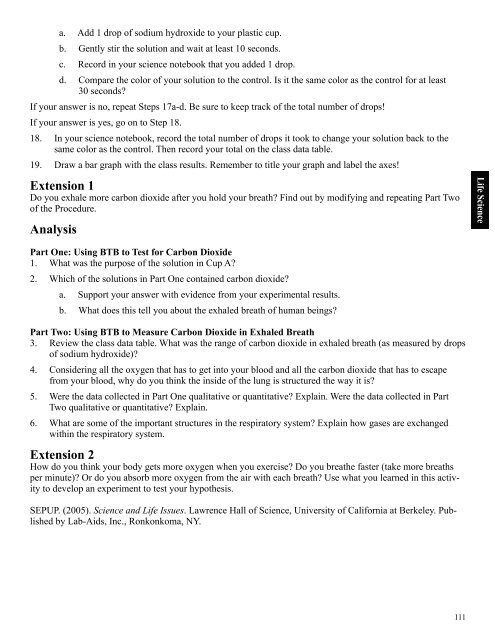ScienceMakers Toolkit Manual - The History Makers
ScienceMakers Toolkit Manual - The History Makers
ScienceMakers Toolkit Manual - The History Makers
You also want an ePaper? Increase the reach of your titles
YUMPU automatically turns print PDFs into web optimized ePapers that Google loves.
a. Add 1 drop of sodium hydroxide to your plastic cup.<br />
b. Gently stir the solution and wait at least 10 seconds.<br />
c. Record in your science notebook that you added 1 drop.<br />
d. Compare the color of your solution to the control. Is it the same color as the control for at least<br />
30 seconds?<br />
If your answer is no, repeat Steps 17a-d. Be sure to keep track of the total number of drops!<br />
If your answer is yes, go on to Step 18.<br />
18. In your science notebook, record the total number of drops it took to change your solution back to the<br />
same color as the control. <strong>The</strong>n record your total on the class data table.<br />
19. Draw a bar graph with the class results. Remember to title your graph and label the axes!<br />
Extension 1<br />
Do you exhale more carbon dioxide after you hold your breath? Find out by modifying and repeating Part Two<br />
of the Procedure.<br />
Analysis<br />
Part One: Using BTB to Test for Carbon Dioxide<br />
1. What was the purpose of the solution in Cup A?<br />
2. Which of the solutions in Part One contained carbon dioxide?<br />
a. Support your answer with evidence from your experimental results.<br />
b. What does this tell you about the exhaled breath of human beings?<br />
Part Two: Using BTB to Measure Carbon Dioxide in Exhaled Breath<br />
3. Review the class data table. What was the range of carbon dioxide in exhaled breath (as measured by drops<br />
of sodium hydroxide)?<br />
4. Considering all the oxygen that has to get into your blood and all the carbon dioxide that has to escape<br />
from your blood, why do you think the inside of the lung is structured the way it is?<br />
5. Were the data collected in Part One qualitative or quantitative? Explain. Were the data collected in Part<br />
Two qualitative or quantitative? Explain.<br />
6. What are some of the important structures in the respiratory system? Explain how gases are exchanged<br />
within the respiratory system.<br />
Extension 2<br />
How do you think your body gets more oxygen when you exercise? Do you breathe faster (take more breaths<br />
per minute)? Or do you absorb more oxygen from the air with each breath? Use what you learned in this activity<br />
to develop an experiment to test your hypothesis.<br />
SEPUP. (2005). Science and Life Issues. Lawrence Hall of Science, University of California at Berkeley. Published<br />
by Lab-Aids, Inc., Ronkonkoma, NY.<br />
111<br />
Life Science










